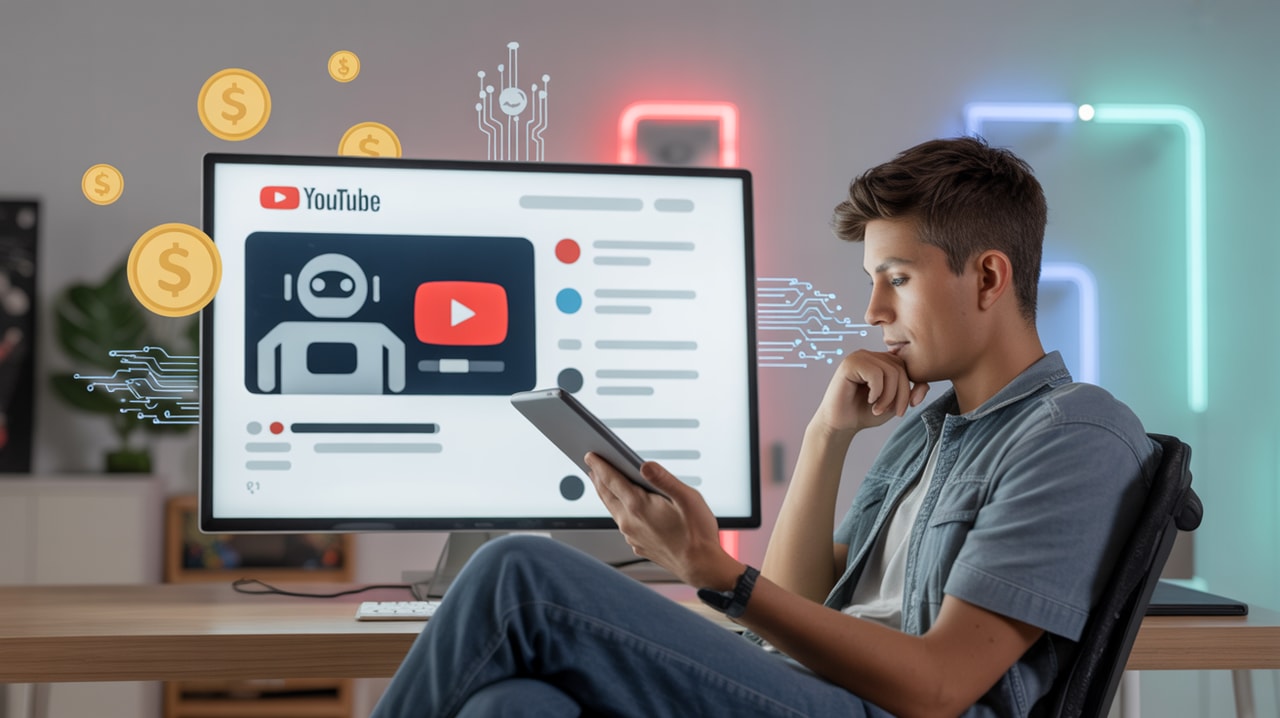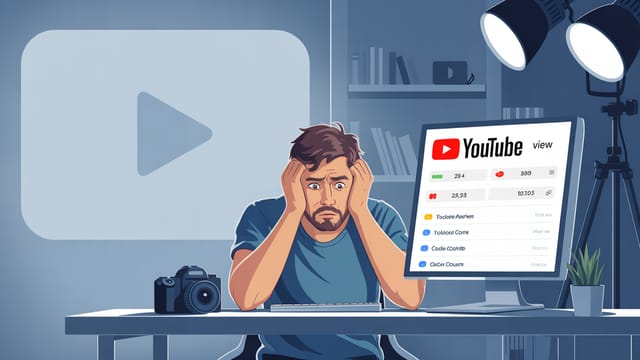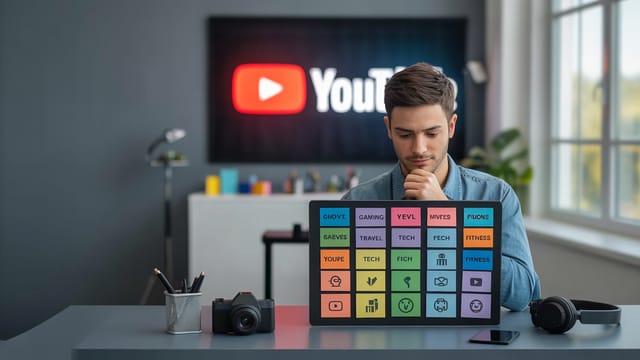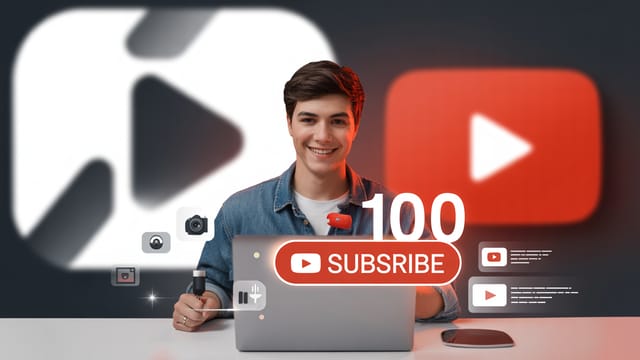
Ready to get your next 10,000 subscribers?
Join thousands of creators who use Subscribr to create faster, better YouTube videos.
Monetizing AI-Generated YouTube Videos: What YouTube Actually Allows
AI has exploded onto the creative scene, offering incredible new possibilities for YouTube content. From AI-generated visuals and music to AI voiceovers and script assistants, these tools are empowering creators in exciting ways. But with rapid technological advancement comes questions, perhaps the biggest for any creator being: Can you actually make money with AI videos on YouTube?
Navigating YouTube's monetization policies, especially as they adapt to new technologies, can feel like walking a tightrope. This article dives into what YouTube's current stance is on monetizing content created with the help of artificial intelligence, how it affects your eligibility for the YouTube Partner Program (YPP), and how you can use AI responsibly while aiming for monetization.
YouTube's Evolving Stance on AI Content
YouTube hasn't drawn a strict, hard line saying "no AI content allowed." Instead, they view AI as a tool, much like a video editor or a camera. However, the key distinction lies in how that tool is used. The platform's core focus remains on rewarding original, engaging content that provides value to viewers.
The conversation around AI monetization is relatively new, and policies are still developing. What's clear is that YouTube is looking at the spectrum of AI usage. On one end, you have creators using AI to enhance their original ideas – perhaps generating unique visuals based on their concepts, using an AI assistant for brainstorming, or employing AI tools to speed up editing. On the other end, you have purely automated processes that might scrape content or generate formulaic videos with minimal human input or creativity.
It's likely that the line for monetization eligibility will be drawn somewhere on this spectrum, favoring content where AI serves as a creative aid rather than the sole engine of production.
The Core Principle: Added Value and Transformation
Based on current understanding and insights from creators working with AI, the most critical factor for monetization is added value and transformation. YouTube's monetization policies have long emphasized that content must be original and significantly transformed if it incorporates third-party material. This principle extends to AI-generated elements.
Simply taking raw output from an AI tool – like a slideshow of steady AI images with a basic text-to-speech voiceover and no editing – is generally considered low-value content. YouTube's policies on repetitive or repurposed content aim to prevent channels that offer little unique value. Content that feels mass-produced or lacks creative effort falls into this category.
To make AI-assisted content eligible for monetization, you must add significant value through your own creative input. This means:
- Editing: Combining AI-generated visuals with stock footage, images, text overlays, transitions, and effects.
- Scripting & Narration: Providing insightful commentary, a compelling narrative, or a unique perspective. Even with an AI voice, the script and overall presentation matter.
- Structure & Flow: Organizing the content logically and engagingly.
- Sound Design: Adding relevant background music and sound effects.
- Research & Analysis: Using AI to research topics but then synthesizing that information into an original script and presentation.
Think of it this way: Are you using AI to create something new and interesting, or are you just presenting AI's output? The former is likely eligible; the latter is not.
Monetization Eligibility: What Qualifies?
Channels using AI-generated elements can absolutely be monetized if they adhere to the principle of added value and transformation. Here's what tends to qualify:
- Videos combining various assets: Content that creatively mixes AI-generated images, AI-generated video clips, stock footage, stock images, and human-created elements. The key is how these are edited together to form a cohesive, original video.
- Content with significant editing and production value: Videos where substantial effort has gone into the editing process – adding transitions, text overlays, graphics, pacing, and overall flow – even if some assets are AI-generated.
- Faceless channels with AI voices: These can be monetized, provided the visual content and script add significant value. Simply reading an article with an AI voice over unrelated visuals won't work. You need engaging visuals (stock, AI, or a mix) that are relevant and presented dynamically, combined with a well-written script.
- AI as a tool for specific elements: Using AI for script outlines, brainstorming, generating background music, or creating specific visual effects within a larger, human-driven creative process.
What Doesn't Qualify (Low-Value Content)
To avoid demonetization or rejection from the YPP, steer clear of content that YouTube typically flags as low-value, especially when AI is involved:
- Simple slideshows of AI images: Presenting a series of static AI-generated images with minimal editing or commentary.
- Reading articles or text with an AI voice: Taking public domain text or articles and simply having an AI voice read them over generic visuals.
- Repurposing content without transformation: Using AI to slightly alter existing videos or content from elsewhere without adding significant original value.
- Mass-produced, formulaic content: Creating large volumes of highly similar videos using automated processes with little to no creative input or variation.
Navigating Copyright and Ethical Dilemmas with AI Content
One of the significant pain points for creators using AI is navigating the complex landscape of copyright and ethics.
- Copyright of AI Output: The legal status of copyright for purely AI-generated content is still being debated globally. In many jurisdictions, content must have a human author to be copyrightable. This means relying solely on AI output could leave you vulnerable.
- Training Data Issues: Some AI models are trained on vast datasets that may include copyrighted material. While the output might be transformative, legal challenges regarding the training data are a potential risk.
- Likeness and Personality Rights: Using AI to generate likenesses of real people (including voices) without consent raises serious ethical and legal issues. YouTube's policies prohibit synthetic media that deceptively impersonates someone.
- Transparency: There's an ongoing discussion about the ethical obligation to disclose when content is AI-generated, especially deepfakes or synthetic media that could mislead viewers. While YouTube doesn't currently mandate labeling for all AI content, this could change, and being transparent builds trust with your audience.
To mitigate these risks, focus on using AI tools responsibly:
- Understand the terms of service and training data sources of the AI tools you use.
- Avoid generating or using likenesses of individuals without explicit permission.
- Prioritize adding your own creative flair and transformation to the AI output.
- Consider adding a disclaimer if you use AI in a way that might be unclear to viewers, especially synthetic media.
Keeping Up with Rapid AI Advancements and Policies
The field of AI is evolving at breakneck speed, with new tools and capabilities emerging constantly. Along with this, platforms like YouTube will continue to refine their policies.
To stay ahead:
- Follow official YouTube Creator Insider channels and blogs for policy updates.
- Engage with the creator community discussing AI and monetization.
- Experiment with new AI tools but always consider the "added value" principle.
- Be prepared for policies to change as the technology matures and its implications become clearer.
Ethical AI for YouTubers: A Comprehensive Guide to Navigating Copyright, Transparency, and Bias
Beyond just monetization, adopting an ethical approach to using AI is crucial for long-term success and maintaining a positive relationship with your audience and the platform. This involves:
- Transparency: Being open with your audience about your use of AI tools can build trust.
- Avoiding Bias: Be mindful that AI models can reflect biases present in their training data. Review AI-generated content critically to ensure it doesn't perpetuate harmful stereotypes.
- Originality: Use AI to augment your creativity, not replace it entirely. Develop your unique voice and perspective.
- Respect for Copyright: Understand the potential copyright issues and aim to create content that is clearly transformative and original.
Leveraging AI for Analytics and Understanding Your Audience
While AI for content generation is a hot topic, AI can also be a powerful tool for understanding your channel's performance and audience. Platforms like Subscribr leverage AI to provide deep insights into:
- Channel Performance: Analyzing metrics, growth velocity, and identifying successful content patterns.
- Audience Insights: Generating detailed audience personas based on data.
- Competitive Analysis: Studying successful channels and videos in your niche to identify trends and opportunities.
- Video Breakdown: Analyzing the structure and elements of high-performing videos.
Using AI for analysis (like Subscribr's Intel features) can inform your content strategy, helping you create videos that are more likely to resonate with your target audience and perform well – which, in turn, supports monetization.
Getting Your AI Channel Monetization Ready
Based on YouTube's current approach, here are actionable steps to take if you're using AI and aiming for monetization:
- Focus on Transformation: Ensure your editing and creative input significantly transform any AI-generated elements.
- Prioritize Quality: Produce high-quality videos with good visuals, clear audio (even with AI voice), and engaging pacing.
- Combine Assets: Don't rely on a single source (like only AI images). Mix AI output with stock footage, personal recordings, and other creative elements.
- Add Your Voice (Figuratively or Literally): Provide unique commentary, analysis, or a narrative structure that only you can offer. If using an AI voice, ensure the script is original and insightful.
- Understand Low-Value Content: Familiarize yourself with YouTube's guidelines on repetitive and repurposed content and actively avoid creating videos that fit those descriptions.
- Stay Informed: Keep up with YouTube's policy updates regarding synthetic media and AI.
- Consider a Channel Review: If you're unsure if your content meets the standards, getting a professional channel review focused on monetization readiness for AI content can provide valuable feedback. This type of service, focusing on how your specific AI implementation aligns with YPP guidelines, can be highly beneficial.
Tools & Resources: Powering Your AI Channel with Subscribr
Creating monetizable AI content requires not only creative skill but also strategic planning and analysis. Subscribr is designed to support creators using AI by providing tools that help you:
- Research: Use the Research Assistant to gather information and analyze existing content, including YouTube transcripts, to inform your scripts.
- Plan: Define your content angle and goals using the Frame Development tools to ensure your videos have a clear purpose and add value.
- Script: Utilize the AI Script Writer to generate outlines and drafts, which you can then refine and transform with your unique perspective.
- Analyze: Leverage the Channel and Video Intel features to understand what's performing well in your niche and identify strategies to apply to your AI content.
- Maintain Consistency: Use Voice Profiles to ensure your AI-assisted scripts maintain a consistent tone and style that aligns with your brand.
By integrating tools like Subscribr into your workflow, you can streamline the process of creating high-quality, transformative content that meets YouTube's standards for monetization.
Conclusion
Monetizing YouTube videos that use AI is possible, but it requires a strategic approach focused on adding significant value and transforming the AI-generated elements. YouTube is looking for original, engaging content that goes beyond simple AI output. By prioritizing quality, creativity, and responsible AI usage, and by staying informed about evolving policies, creators can successfully navigate the path to monetization in this exciting new era of content creation. Focus on creating videos that your audience loves and that showcase your unique creative input, and you'll be well on your way.





